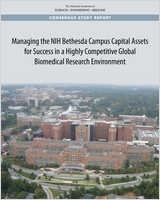From: 6, NIH Current Approach to Strategic Planning for the Bethesda Campus Buildings and Facilities

NCBI Bookshelf. A service of the National Library of Medicine, National Institutes of Health.
Stanford University is an example of a large-scale research enterprise with a capital plan similar to the ambition of the most recent NIH Intramural Research Program capital budget request. A private academic research institution and, of course, not subject to federal compliance as an Department of Health and Human Services Operating Division, Stanford University's “Capital Plan” utilizes a 3-year plan that identifies only those projects that have been approved, including funding sources identified (or nearly so), and includes three major categories for fiscal year (FY) 2017 to FY 2020: “Projects in Design and Construction” ($2.9 billion, see Table 6.2.1); “Forecasted Construction Projects” ($3.5 billion); and “Infrastructure and Other [Housing]” ($4.3 billion). Operating budget impacts for institutional operations and maintenance expenditures are included along with projected cash flow expenditures (often beyond the 3-year plan) integrating institutional operating and capital financial management as required due to funds sources requirements and related financial commitments by schools or departments or philanthropic organizations or individuals. Stanford's longer-term capital plan is a more flexible forecast and evolves based on financial feasibility or shifts in institutional priority.
SOURCE: Stanford University, 2017a, “Capital Plan and Capital Budget,” Chapter 4 in Stanford University Budget Plan 2017/18, https:
Stanford University 2017/18-2019/20 Capital Plan (in millions of dollars).
From: 6, NIH Current Approach to Strategic Planning for the Bethesda Campus Buildings and Facilities

NCBI Bookshelf. A service of the National Library of Medicine, National Institutes of Health.